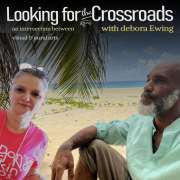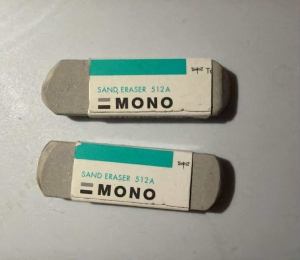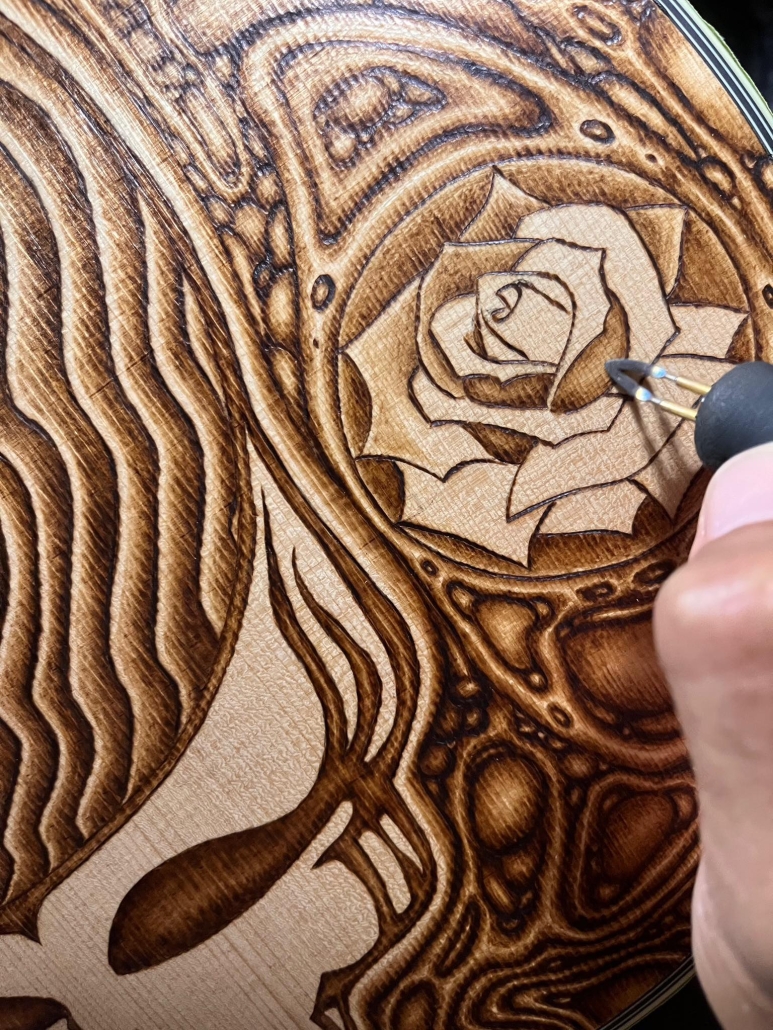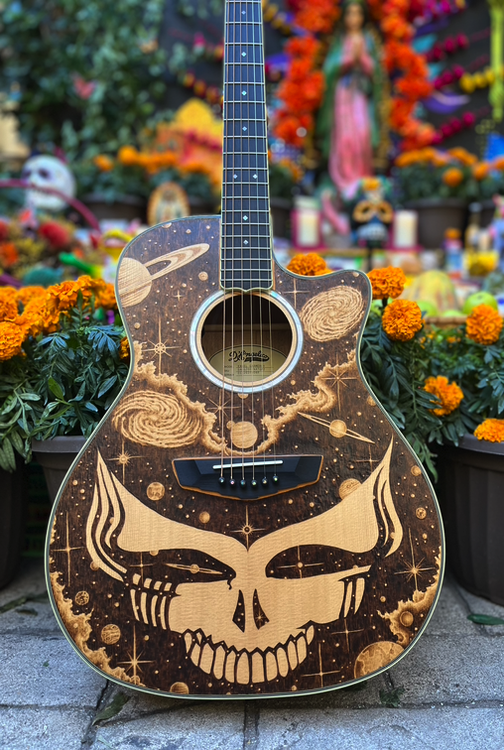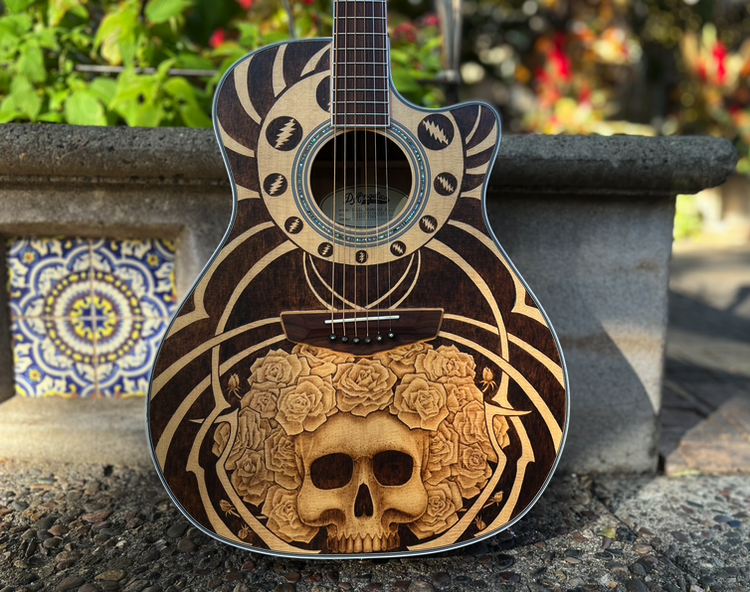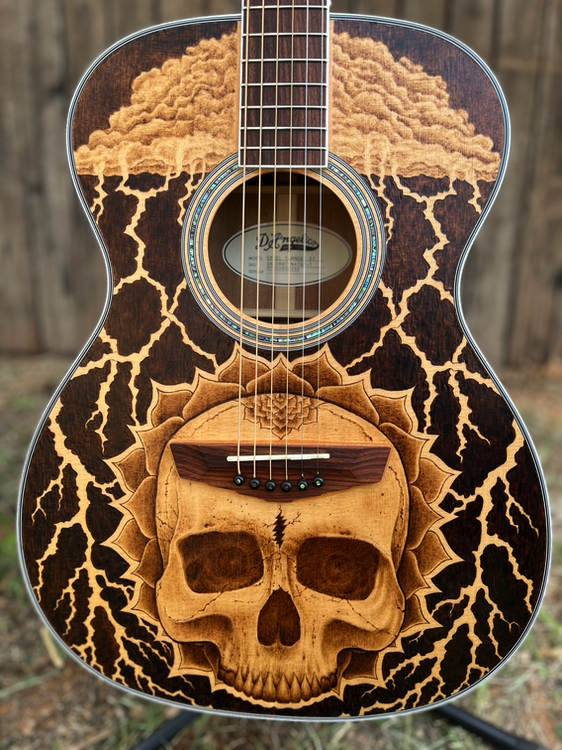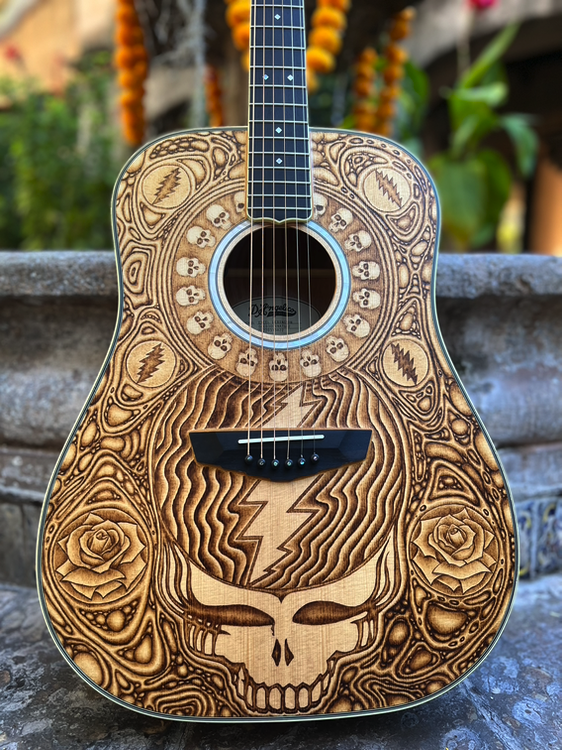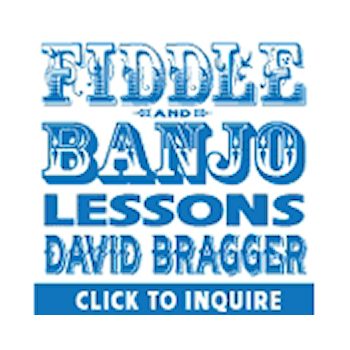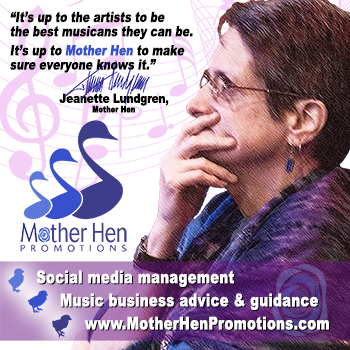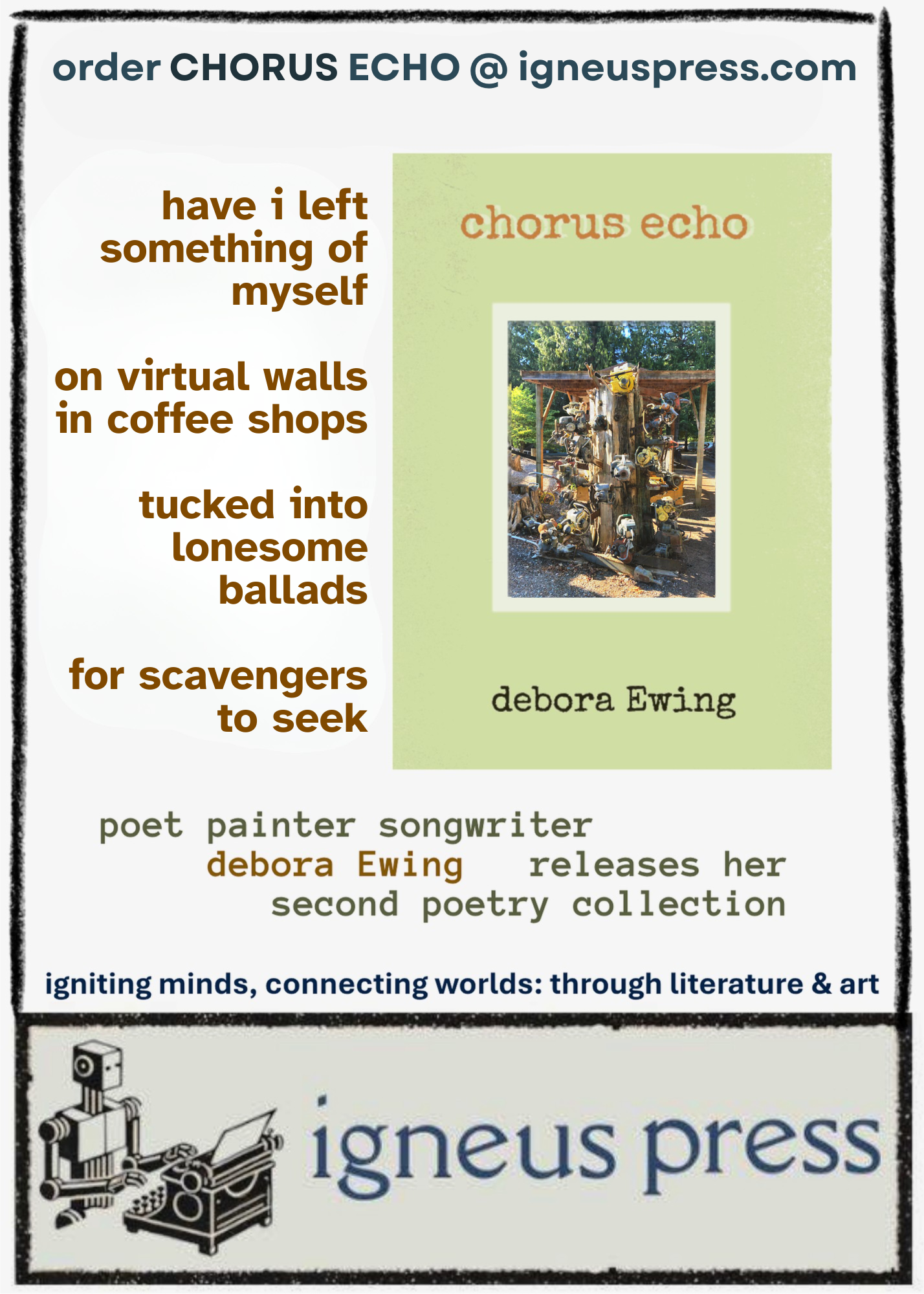Dig O’Neal – Tattoo Your Guitar
working within the flow: sound, bodies, wood
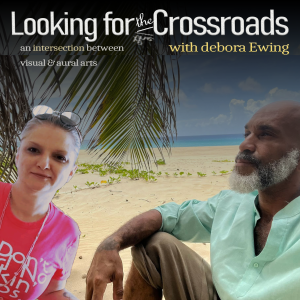 Burner of guitars Dig O’Neal has personal history wide and detailed as a world map. He was born in San Juan, Puerto Rico, and grew up in the British Virgin Islands. When he was eight, his parents got divorced. His mom took Dig and his little sister back to America…
Burner of guitars Dig O’Neal has personal history wide and detailed as a world map. He was born in San Juan, Puerto Rico, and grew up in the British Virgin Islands. When he was eight, his parents got divorced. His mom took Dig and his little sister back to America…
The following is my interview with Dig O’Neal:
DO’N: …or to America for us. We went first to Colorado, where my grandfather was. We then went to Chicago for my mom to get her master’s in social work. I have such respect for people who are social workers. It’s a really challenging job; she was dealing with the worst elements of human society.
I remember times where I was definitely not acting like I appreciated the abundance in my life. I felt whatever a teenager might feel. She would take me to – it just chokes me up to think about – she would take me to houses where the children were being horribly abused; this was her day-to-day experience. She wanted me to see: “You don’t have it as bad as you might think when I don’t let you go out after nine o’clock on a weekday with your friends.”
So we went Chicago, back to Colorado, and between all of this, I would bounce back and forth between my mom in the States and my dad in the Virgin Islands. Then, when I became an adult, I moved back to Chicago, and now I’ve been in Arizona for 25 years. I’m in a small town just south of Sedona. Everyone seems to know where Sedona is.
dE: Arizonans give directions in altitude.
DO’N: We’re about 3,300 feet where I am. Sedona is 4,500 feet, and if you go 45 minutes north, you hit Flagstaff, which is about 7,000 feet. And then if you go an hour, two hours or so south, you’re at sea level in Phoenix and Mesa.
Arizona is an amazing state. You go from really low barren desert to very high ski town with snowy mountain peaks most of the year with pine forest. It’s creeks and rivers… people often think of Wiley Coyote and the Road Roadrunner in terms of what Arizona looks like, but there’s more to it than that.
dE: I’m laughing because I just found, somewhere on the map, a place called Nothing, Arizona, zip code of 85360. I feel like I want to go there.
I got the sense from following you on Facebook that you have a lot of diverse experience to draw from, and I knew there was a Virgin Islands connection, so it’s interesting that it’s the British side. But I’ve been following you because of your amazing guitar work. I also learned that you used to be a tattoo artist. Explain how you decided to give that up.
DO’N: Two elements got me to retire from tattooing after loving it for 20 years, and I still have great fondness for it. I was tattooing rather successfully; I had people that were coming from all over the world to see me. I was booked out over a year in advance at my peak.
But as a tattoo artist, it’s hard not to feel compelled to work as long as the client is willing to sit. I often found myself sitting for really long 8, 9, 10, 11-hour sessions. It would be a lot of this motion (making a stretching motion with fingers and thumb of one hand) with pressure – to stretch, make the skin taut – and in this hand, I would hold a machine that vibrated like crazy for, again, extended periods of time, and it resulted in a severe carpal situation.
But besides the carpal situation, which really forced me to curtail my tattooing, I could never quite reconcile with the fact that I was putting what I would consider questionable substances into people’s skin.
When I say questionable, I mean that I have spent a lot of time researching. I looked very thoroughly into it. I collaborated with scientists at the University of Northern Arizona on experiments, providing my pigments for them to examine. It’s hard to get around putting heavy metals into people’s skin. I don’t know how much you know about heavy metals; it’s a serious thing.
dE: Yeah. I studied ceramics for years. A lot of the brightest colors are toxic.
DO’N: It wasn’t like I was lazy about it. I tried to find the safest pigments that also resulted in the brightest outcome. However, there was no way around the fact that you’re working with a substance that can cause serious repercussions in the human body.
So these factors just kind of collided. It was 10 years ago that I retired, and when I retired from that, I was looking for other art outlets. My wife proposed woodburning, which had zero appeal to me.
But 30 years ago when I started tattooing, I had never really seen the width and breadth of what you could do with a tattoo. I associated them with a negative element of our society, with people who got them in jail with poor quality artwork, with tattoos that didn’t heal well. So it took somebody in my family saying, “Hey, I want a tattoo. Can you learn how to do it and do it for me?”
I reluctantly learned about tattooing and found there was a whole world and tremendous artistic potential; also tremendous personal and spiritual significance with the tattoos. That opened me up to tattooing.
Similarly, woodburning had zero appeal to me. As I started to look into it more, it blew my mind. Everything I could do with the skin, I can do with woodburning. However, it still didn’t really click for me at first because I didn’t feel like there was a niche that I wanted to really dive into.
So many people do woodburn art and go to county fairs, state fairs, selling on Etsy… might be stuff like plaques, pendants, it might be earrings, what have you. But nothing of it spoke to me until I had an epiphany that I could work on guitars. I’ve loved music, and I’ve loved specifically guitars and guitar music forever – since I was a young child.
That clicked for me. I can do this at a high level. I can bring my tattoo sensibilities to this. And by tattoo sensibilities, I mean the ability to work with somebody on an individual level to create art that’s highly personalized, customized, speaks to them, speaks to their story, is something that unlike tattooing can be passed on through generations.
Here’s a tidbit that I’m sure you’ll find interesting: Among other things, like high-quality cover-ups, I became sought after within the world of tattooing was because I would work with the ashes of the deceased.
I would sprinkle some ashes into the pigments and work with people, with that connection to their beloved. And I realized that was something I could do with woodburning guitars. I’ve had people send me ashes I’ll put into the finish – because when I’ve completed a guitar, I spray it with a sealant. I can put the ashes into the sealant or the ashes directly onto the surface of the wood and burn them into the wood.
And one more crossover that I’ll mention: I spent 20 years working on human bodies, complicated or intricate large pieces, and when we refer to guitars, we refer to them as a guitar body. A lot of the principles that I used with tattooing in terms of how to take advantage of the shape of a human body translate to the guitar, specifically if I was doing a back piece or a full chest piece, which were two of my favorite things to do. I can take that concept and apply similar principles of art: how movement flows across the surface, whatever the design calls for. It applies to a guitar, which is a neat thing to see for me as an artist.
dE: Oh, yeah. I paint guitars sometimes. I get it that you work with the shape, and it’s the same I’ve been told with music in a band. Musicians want to work with the shape of the music instead of just saying, “Here’s my sound: Listen to me.” It has to fit. And there’s enjoyment in working with the curves, finding them, feeling ’em, finding out what your canvas wants to say.
You brought up one of the things I was going to ask you about: whether you take the finish off the guitars first? Yes, you do, because you put it back.
DO’N: Sometimes if I’m working directly with a luthier – a luthier is somebody that makes guitars – it’s common for them to send me the ununited part of the guitar.
dE: Oh, that’s horribly convenient, isn’t it? Yeah. Do you have favorite kinds of wood that you like to work with?
DO’N: Well, yeah, and I would say that because of the nature part, there are some woods that are more common than others for sure. But I like – for the way that it receives the artwork, for the way that it receives the pyrography, the woodburning – I love cedarwood. However, cedarwood is not my favorite to work on because it’s kind of a darker wood. I also really like mahogany, and Sapele.
me (googling): Oh, that’s pretty. So is it easier to work with very dense wood or the softer?
DO’N: So the kind of wood that works best for me is spruce wood. That’s very fine grain sometimes.
dE: Yeah, that makes sense.
DO’N: Sitka spruce is very, very popular and super common on what we call the soundboard. The soundboard is part of the guitar that everyone sees that has a sound hole in it. And Sitka Spruce, depending on the quality of it, can be excellent for me to work with. Or if it’s on a less expensive guitar, it can be problematic if the grain is wide because a pine, if it’s wider, can be a little bit sappier. And that can produce unpredictable results. I’m at a point where even with the unpredictable woods I can predict and work with them successfully, but some are definitely easier than others.
So the finer the grain, the harder the wood, relatively speaking. Often on acoustic guitars, it’s not usually a very hard wood that they use on the soundboard, softer wood, or relatively speaking on the scale of wood. I enjoy working on all of them.
dE: I’ve got a friend who has detailed spreadsheets on which woods resonate how much. So I’m asking this question in part for him.
DO’N: One question that I’m sure he’ll have is this: How does the work that I do affect the sound?
dE: Yes.
DO’N: Voicing, whatever you want to call it: that’s a question I get often, especially from the luthier community I’m part of: How does this affect the sound – is it positive, is it negative, significant? And without going too into the weeds on that one, I would say that yes, it influences the sound of the wood because everything has an effect on the sound of the wood. I would say it has a minimal effect on the sound of the wood.
And this isn’t just based on a conjecture or my opinion. This is based on years of me having worked with professional musicians, sound engineers, and other performing artists, a lot of whom were able to hear the guitar before and after. One of the things that I’ve been educated about from my luthier friends is that what type of a finish you use – a polyurethane or a shellac – can have significant effect on the resonance and the sound of a guitar.
Likewise, if you’re playing an acoustic and you put a pick guard on the part where the downstroke strums hit, that will effect the the resonance of a guitar, because it’s a piece of plastic on the surface. If you play the fretboard with your left hand and strum with your right, a lot of people will rest this part of their arm on the soundboard, and that has a dampening effect.
So in the grand scheme of things, what I do has very, very little effect on the resonance of a guitar. That said, again, it would be disingenuous to say that singeing the surface of a guitar is going to have zero effect on it; however it is barely noticeable. I’ve never had anyone honestly say to me anything other than they think it sounds better.
dE: I have some input on that. Randy Parsons is a luthier who bought a church in the middle of Kansas somewhere. I got wind of him because he used bone for braces in his early builds. He doesn’t do that anymore, but he sometimes puts things inside the guitar, like secret messages or a little circus tent that lights up, sometimes skulls and whatnot.
Part of his process is what he calls his burn box, because he said he once got hold of a guitar that had been through a fire and sounded great. He found out that heating the wood does something to the sap that does something to the resonance of the guitar.
DO’N: You know what I think he’s referring to? There’s a term for that, if I’m not mistaken: Torrefaction. Some luthiers will actually torrify the wood to make it sound better, which isn’t exactly like what I’m doing, but there is that element, a very similar transmutation that occurs when you add heat.
Years and years ago, I made a post on a luthier group asking a question about a certain very unique guitar that somebody wanted me to work with. Something was posing a bit of a conundrum for me that had to do with the bridge.
So many people chimed in saying, “How can you do that to that guitar? You’re going to destroy that guitar!” The person who’d hired me to do the work ended up hearing about this, and joined the Luthier group to post something like, “look, I want him to do this to my guitar. I understand the value of this guitar, and I’m still choosing to do this, and I don’t think it’s a bad thing.” This was years ago.
He recently chimed in back on that old post, sharing a picture of the guitar I’d finished years ago, saying, “Hey, I just wanted to follow up with you guys who were giving Dig a hard time. This is the guitar, and it sounds even better than it did before. So just for you to know.”
dE: That makes sense. Woodburning seems similar to scratchboard art in that it matters a lot where you start. There are no do-overs. Can you make a mistake and erase it?
DO’N: Technically, to an extent. If there was a significant mistake – and this has never happened – but let’s say I misspelled something. I could technically sand that little bit away. But sanding on a surface that’s supposed to be completely smooth, or at least level, can create a little divot. So really it would be an extreme emergency scenario to make me use sandpaper to remove something that was woodburned. Now I will use this tool… an eraser that has small granules of some kind of a silicate in there.
It’s a rough eraser that will gently remove whatever’s on the surface of the wood. So let’s say that I’ve finished the design completely, and I want to just bring out some of the white highlights that might have gotten lost a little bit from me just touching the surface. I might go to the reflection of light in somebody’s eye, or residue from transferring the design to wood with carbon paper or pencil. If you can see a little bit of the pencil where you shouldn’t, then I might use this to erase it. Because just a regular eraser won’t necessarily remove things from wood.
dE: Okay, so let’s talk about your designs here. I’ll tell you the ones I like. This lower left hand corner is one of my favorites. I love the wave patterns.
DO’N: Oh, thanks. That’s actually an ukulele. If you look on the inside, it says TYDE. It’s a custom ukulele company. I had free reign to do whatever I wanted to do, and that’s what I came up with. I like doing kind of abstract stuff when given freedom. I remember naming that one Ripple. I believe that we’re going to be collaborating on more stuff in the future.
dE: I’m watching your video “A Brief Glimpse… My Art, in Under 60 Seconds.”
dE: …I don’t know that much about wood burning equipment, but it looks like a very fancy looking point. It’s got a unique shape working on a guitar that’s got an eagle, and you’re working on the feathers. Do you design your own tips for some projects?
DO’N: I didn’t design that one myself. You can see that it attaches to like a stirrup, and it’s like a thick piece of wire. The way I would design a tip is I would bend it and hammer it into the flatness and the shape that I want it to be, hammer against the piece of metal. I’ve definitely done that, but it’s easier to just buy them.
dE: I find a lot of times art is aided by constraints. If you have an idea, but you have to use this tool to make it happen, that changes your overall outcome and is often for the better.
DO’N: And in terms of tips, in terms of tools to work with, I have a fancy, pretty high quality heat control unit that allows me to precisely adjust. That’s an asset. And then in terms of tips, I have pens with interchangeable tips, and I probably have 50 different pens, pen tips, like you would have with brushes. If you have a bunch of different paintbrushes, you’ve got a few that are your favorites, but you have a bunch for different applications.
dE: Yes, Including some that – if I don’t know how this is going to work, and it’s probably going to destroy the brush, I can use one of these. Let’s talk about some more of your specific works.
DO’N: There’s a series – recognize the Grateful Dead theme in there. Those I was hired to do for the current popular offshoot of the Grateful Dead called Dead and Company. Those were subsequently signed by the band and auctioned for charity. Those guitars have gone on to raise, I want to say right around half a million dollars, to help raise voter awareness specifically. That’s kind of a neat little offshoot of what I do.
dE: Oh, that’s very cool.
DO’N: This one with the heart was for an artist by the name of Trevor Hall, and he subsequently played it, signed it, and that one auctioned off for about $5,000 also to raise money for charity. That one was to feed those in need to help feed people who were needy. Every one of these has a story that is intimate to the person who owns it and is near and dear to my own heart because of that.
dE: I feel like there’s more of a connection this way than there with, when I make a painting and I sell it to somebody, they purchase it because it speaks to them, and they appreciate me for creating it, but we don’t really have a connection usually beyond that point.
DO’N: Occasionally somebody will pop up who stays in communication, but for the most part, I don’t meet them in person with rare exceptions. And for the most part, I have little to nothing to do with them after the process, which is different than my years of tattooing. Oftentimes spend all of that time with that person while I was doing a 40-hour tattoo.
But with the guitars, I would spend all that time doing the guitar by myself, then send it to them. And it wasn’t that there was appreciation, but it wasn’t the same. At least not to the same level.
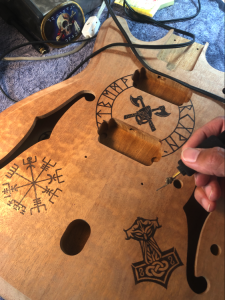
guitar with runes, by Dig O’Neal
They all tell a story. They all have intimate little details. Like this one here, if you look closely has it has an eyeball, which has three sunflowers. In this case, this gentleman put that eyeball in there with the three irises to represent his daughters. Little stuff like that, or this one here has, if I recall correctly, it looks like Celtic runes, but really it spells names of the man’s family.
This gentleman here got this guitar right next to him. His name is John Butler; he’s one of Australia’s top selling artists. He’s got one of my guitars.
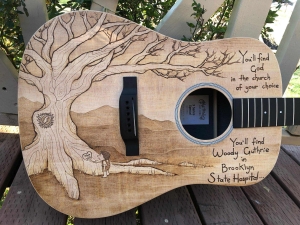 I have one that somebody did as tribute – to Bob Dylan, the Grateful Dead, Sublime, and Woody Guthrie – and it has a quote from Bob Dylan that he read at Woody Guthrie’s memorial.
I have one that somebody did as tribute – to Bob Dylan, the Grateful Dead, Sublime, and Woody Guthrie – and it has a quote from Bob Dylan that he read at Woody Guthrie’s memorial.
Dylan came up on stage or to the podium. He began it by saying he was told to keep it short, and then it was like a 15-minute massive poem he read for Woody. It was so touching.
Anyway, the guy got that on his guitar: You’ll find God in the church of your choice
You’ll find Woody Guthrie in Brooklyn State Hospital
dE: So you’re also big into martial arts. Do you see similarities in martial arts and creation of art and music, and is there an underlying element between all of these interests?
DO’N: The techniques are vastly different, but one thing that comes to mind is the ability to relax being a very important key in figuring out what to do, to find creative ways to solve problems, or to figure out what will work best.
Oftentimes nothing is more daunting for me than a blank canvas. Likewise, coming up to a guitar and putting those first strokes with a heated tool on it can also be, not intimidating, but kind of like, “Oh boy, here we go.” This is a big project. I’ve got all my reference material on the walls around me. I’ve got the end result firmly envisioned in my brain. Now I’ve got to start the process of putting it onto the wood.
I think that between martial arts and art, there’s the ability to be centered, remember to breathe, and to tap back into the confidence that can sometimes get lost when you’re faced with a challenge.
dE: That makes sense. And so you’re going to teach a philosophy class?
DO’N: I have not started that. My wife said to me the other day, “You’re in a teaching phase these days.”
And it’s true, I am. I’m coaching kids’ jujitsu, which super rewarding and fulfilling because martial arts played a super significant part of my life when I was a young kid. Really helped me find my way in challenging times.
And then I am teaching through a school called Colearn Academy, which is both in-person and remote. I’m doing remote classes, which I’m grateful for. In 2025, so it’s not uncommon – it’s the new way – but I am continually reminded how I would really like to be doing this in person. I’m so enthusiastic to work with these kids about stuff that I’m enthusiastic about. But it’s okay.
I’m doing news media. I’m doing an advanced art class right now, which is very, very fun. That’s online through Zoom. They’re live classes, not prerecorded classes, but it is remote, so I’ve got kids from around the country. Then philosophy is next semester.
dE: What age groups are these?
DO’N: All of the remote classes that I’m doing are eighth to 12th grade, with some exceptions. Some kids are able to get in younger with special permission, so 7th grade-ish.
dE: And what ways do you find to help them interact through the Zoom format?
DO’N: That is the challenge: how to get the kids interacting with me more, and to get them interacting with each other is even a bigger challenge. When you’re not in person, it takes away the impetus to interact. I think some of these kids have been drawn to this particular school because of issues they may have had with traditional in-person school, whether it’s bullying or self-esteem issues or whatever issues might have presented in the school. This, for them, is more comfortable. So being respectful of that is important as a teacher.
When I was first onboarded, it was made clear to me that not all the kids are going to feel comfortable talking. Some of them might not even feel comfortable having their cameras on. For sure, we encourage kids to have the cameras on. We let that be known with the parents and the kids, please have your camera on. But it’s not so draconian that if you don’t have your camera on, you can’t be part of the course.
dE: I think that’s going to end up being more and more important. Zoom is not going away: We can see that now. I think there was a little bit of a foundation in online role playing games – people have teams around the country. I have friends I met in AOL chat rooms because I’m that old. It’s important to understand that this is the world these kids are going into. Where it was just fun for us with AOL and with role-playing games, it was a game. It’s not a game anymore.
DO’N: Right. Well, I predate you on the internet, if that was your time. When I was a teenager still, I was an early adopter of Prodigy. Does that sound familiar? Back in 1987 that I first started being kind of funneled into using this new technology. I was a Deadhead. I was. And so we, early Deadheads, were early adopters of the internet because it gave us a way to keep track of set lists and talk about shows. And – most importantly for us at the time – to trade tapes before streaming services. We would connect with people and say, okay, you send me 10 blanks and I’ll send you 10 shows.
dE: The tapers and traders were just like a community unto itself.
DO’N: This is true.
dE: The phenomenon of the tapers is a very important part of American pop music history. I’m glad you brought that up. And it laid the framework for a lot of what’s currently not going so well in the music industry.
DO’N: You mentioned something when we were conversing prior to meeting that I thought was a really interesting thing. You mentioned something along the lines of connecting with ancestors. Does that sound familiar?
dE: Yes! I’m glad you remembered. I think it’s important to bring it up in everything I do because I feel like the ancestors are trying to talk to us. I keep hearing people say that each of us is a link in a longer chain. When we’re talking about everybody connecting online, there’s this assumption that we’re not really connected, but we are.
These days, people are suspicious of religion, suspicious of fake news. How do we remember to connect with the ancestors and how do we remember who they are? Who we are? Because I feel we all have different ancestors, but at some point they’re all the same.
DO’N: This is very true, and I’m a firm proponent that we are all more similar than – not to sound cliché or trite – but it’s no exaggeration when somebody says, well, beneath the surface, if you cut us, we all bleed red.
Deeper than that, I think we all have commonalities in genetic structure and in shared histories. And the fact that we’re on this relatively little planet doing our best to survive in a massive and vast universe full of potential and possibility, I feel like we are all far more family than we are not. And it breaks my heart, honestly, to see the way that, either through willful ignorance or through being cleverly manipulated, we continue to bicker and fight and treat each other as if we’re not connected. And that is heartbreaking.
I feel like it ebbs and flows – the movements to bring about a more unified awareness or more connectivity – depending on what’s going on, who’s in power or not in power or what catastrophe or who’s talking into which microphone. I make a point of doing my best to feel, to be very welcoming and receptive to everyone.
In all the years since I’ve had social media, I don’t unfriend people. There’s definitely people I disagree with and don’t want to interact with. But I don’t want to create an echo chamber. I don’t want just me hearing from other people who think like me, because then otherwise everything’s a surprise. “Oh, wow, so-and-so got elected or so-and-so happened. I didn’t see that coming.”
Because I’m connected – and whether through tattooing or through wood-burning guitars for anyone – I don’t have any kind of policy that says I won’t work with this kind of person of this political or gender affiliation or this kind of whatever. I will work with anyone, and I will be loving and warm and receptive to everyone because that’s how I feel like I want to go through this world.
That’s helped make me feel more connected to everyone and less disconnected.
And I also feel like the work that I do with guitars and also working with kids is helping me to fulfill what you’re describing there, helping people connect.
dE: I think people have to connect to themselves first.
DO’N: In order. Yes, I agree with that. Let’s be respectful of each other and let’s be respectful of our parents. Let’s look at where we came from and let’s honor this planet. Let’s honor each other. Let’s honor our history, our shared history, our unique history, what makes us individual, what makes us diverse, what makes us similar.
The work I do on guitars I often describe as creating heirloom art because I’m telling the story of a member of a family that will subsequently pass that artwork on for generations to come. That’s something that isn’t lost on me, and that means a lot to me. I feel it’s a great honor to do that. With tattooing, when you pass away, your tattoos go with you.
dE: Ideally…yeah, I just had the image: Let’s keep his skin.
DO’N: They do that. People do that. Places that will take your skin and frame it for you and you can give it to your family or donate it to a museum. So there is that.
dE (wincing): Yeah…
DO’N: I was just talking with my dad – he was kind of lamenting how fast people (where he lives in the Virgin Islands) forget about the past and forget about the people that paved the road for the way things are now. There’s a lack of respect in his mind for that.
Not only do I see that and agree, I feel like it’s no secret that within a hundred to 150 years, even the greatest of kings, the greatest of leaders, the greatest of presidents will all be but forgotten. So that’s when we talk about the inexorable march of time, that’s just part of it. And so it’s like, how do we stay connected when the forces of nature almost conspire against us to forget?
dE: You have to have absolute faith that the piece of the link you built is going to last and it’s going to matter, even if nobody knows what it is. And I think art is a huge part of that because a lot of times the truth can’t really be conveyed in direct terms, but you can make a song, you can make a poem, you can make a piece of art. And that’s still bringing it into the current with us.
DO’N: I think that something that can really help, and it’s not accessible to everyone because it’s not cheap these days, but travel.
Connect with different societies. There’s so much vastness and there’s so much culture out there; so many places that you can go and look at fallen civilizations, whether it’s the Mayans or the Romans, Greeks or the whatever. And you can go to Europe and see these ancient remnants of civilizations and know that this is a long lineage that we’re part of.
dE: I interviewed a Spanish folk band who came to Folk Alliance in Kansas City. I asked them: What was the most American thing you’ve seen so far? They went to a restaurant that everybody recommended for fried chicken. And everybody was very proud of the fact that the building has been there for 200 years. “Most of my neighborhood in Barcelona has been there for 200 years,” they said.
DO’N: I tell you on my mom’s side, my grandfather was a first-generation Russian Jew. Her mother was an African-American lady, and they got together in the early fifties in New York. So you can only imagine what a redhead, white Russian Jew and a dark-skinned African-American had to deal with in the 1950s in New York. But they dealt with it. They both died of alcoholism, but they dealt with it.
Then on my dad’s side there’s a whole plethora of stuff that involves European colonialists and Caribbean native indigenous peoples, and African. So I’m really a mutt, and I’m so grateful for that because there’s no strong sense of identity that I feel can get in the way. Sometimes if somebody feels this, then it’s easy to overlook the experiences or feelings of others.
I’ll say this: my mom and my aunt, her sister, were just a few years apart. And because of their parents, my mom was brown-skinned like me, and my aunt was white-skinned with red hair. Their experience growing up in the early fifties in New York was different. My mom couldn’t go to the same bathroom that her sister could go to or drink from the same fountain that her sister could. And this really shaped their worldviews, but subsequently, that went on to shape my worldviews about how silly some things that we can get hyper-focused on as humans can be.
Having a positive mindset and a deep-seated – for lack of a better word, faith that things will work out, if not for the best on the surface, the way they’re supposed to work out in the long run – can help us get through challenging times.
To touch on all of this in a way that I think brings it together: Ancestry, finding the positive, and finding a way to get through challenging times and finding that which connects us all. I think that music is a really powerful tool for that. And especially there’s something to be said for folk music, which really resonated with me from a young time. Even before I moved to the States when I was eight, there was Caribbean folk music that was called My Culture. And then when I moved to the States, I remember moving to Colorado and in school we would learn Woody Guthrie songs. “This Land is Your Land, this Land is My Land.”
So that for me was my introduction to American culture. Literally, that was the first song that I remember learning. And “If I Had a Hammer” and John Denver songs were a big part of my life as a kid. Bringing it around full circle for me, our family just went with my daughter and my 12-year-old son to see Willie Nelson’s Outlaw tour.
Willie Nelson, Bob Dylan, Billy Strings and Sierra Hull. So not just, not only did my family have my son’s uncle who’s 75, we had a 12-year-old, my daughter’s 28; we had my wife, myself being a person of color in that environment – I was a minority – but that didn’t matter. It was music that was connecting us all.
And we had a similar thing reflected on the stage where we had old man Willie, who’s 93 or something with his kids, Lucas Nelson on stage with him doing this. And Bob Dylan who’s 80-something, still doing those songs that changed the world. And Billy Strings, who if you’re not familiar with is, I mean he’s just a phenomenal virtuoso on guitar and he’s bringing bluegrass back to a level of popularity that I’ve never seen it have. And that is such culturally and historically rich music. And we’ve got Sierra Hull who also combines elements of bluegrass and she plays mandolin, she plays the guitar and she’s a female doing this at high level.
I remember just sitting there outside in Phoenix at the show, just feeling like such completion and such wholeness as we were there for this event, to be there, and gratitude for the music. I just want everyone to be able to connect with each other through music, which is why I’m such a big fan of people going to live music. Go see a show; go to shows.
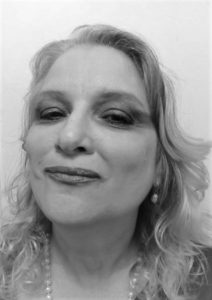 debora Ewing writes, paints, and screams at the stars because the world is still screwed up. She improves what she can with music collaboration, peer-review at Consilience Poetry Journal, or designing books for Igneus Press. Follow @DebsValidation on X and Instagram. Read her self-distractions at FolkWorks.org and JerryJazzMusician.com.
debora Ewing writes, paints, and screams at the stars because the world is still screwed up. She improves what she can with music collaboration, peer-review at Consilience Poetry Journal, or designing books for Igneus Press. Follow @DebsValidation on X and Instagram. Read her self-distractions at FolkWorks.org and JerryJazzMusician.com.
Dig O’Neal – Tattoo Your Guitar
working within the flow: sound, bodies, wood

